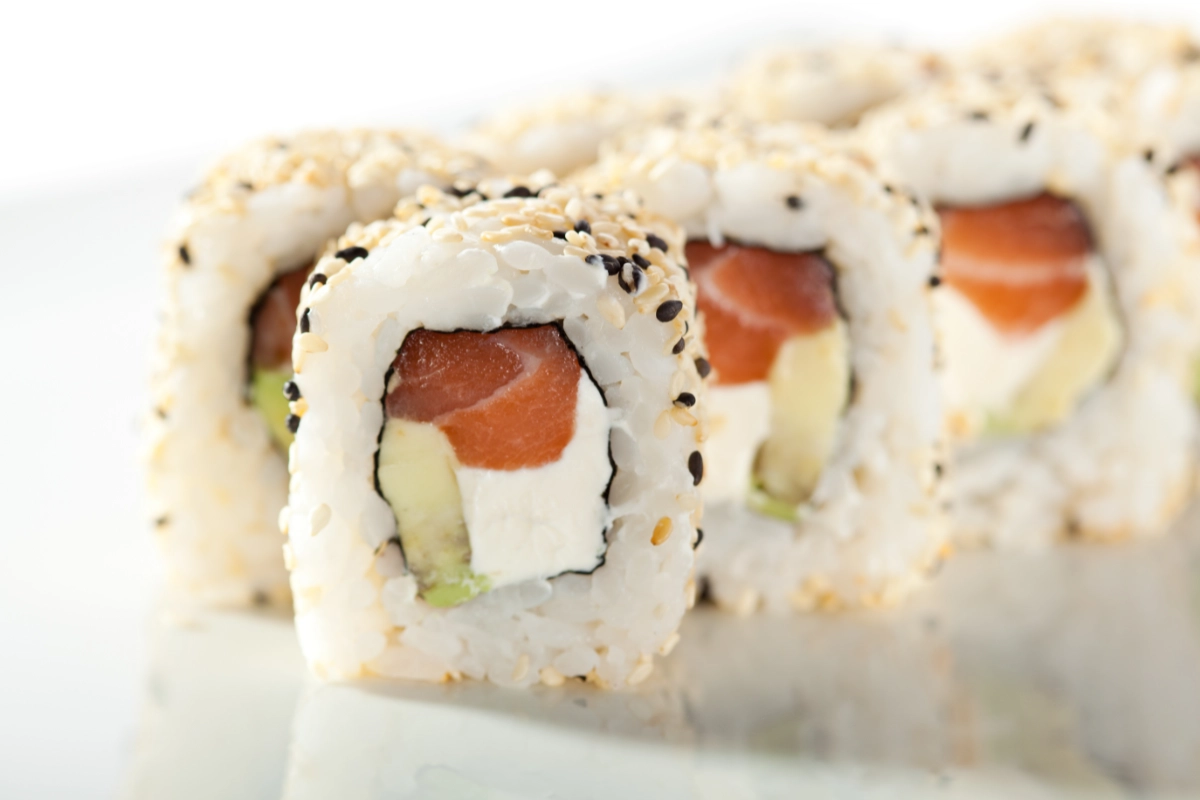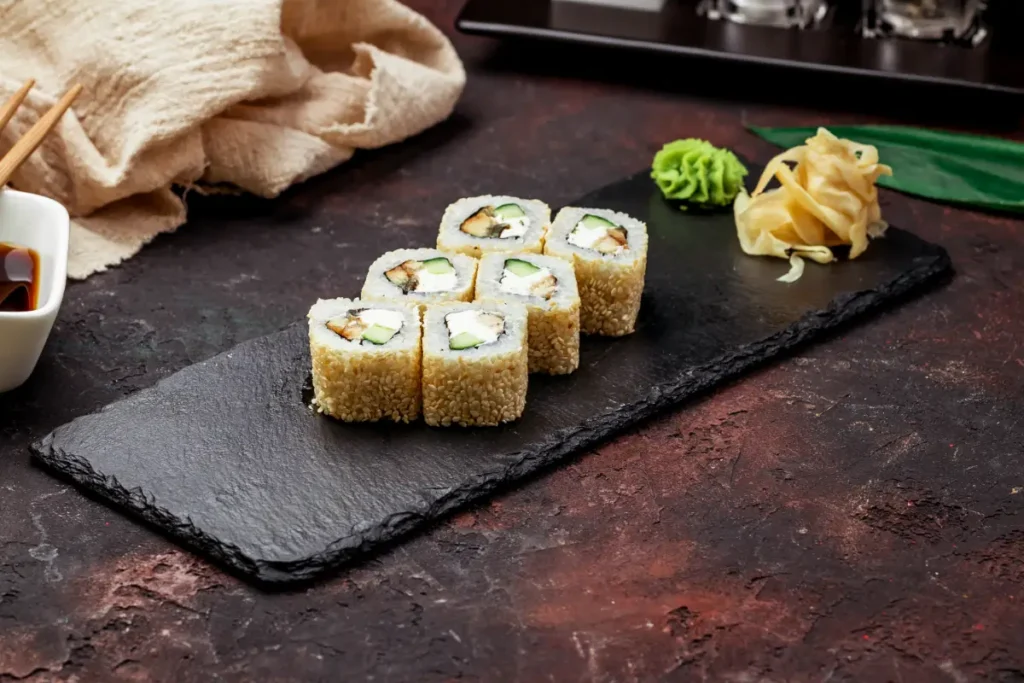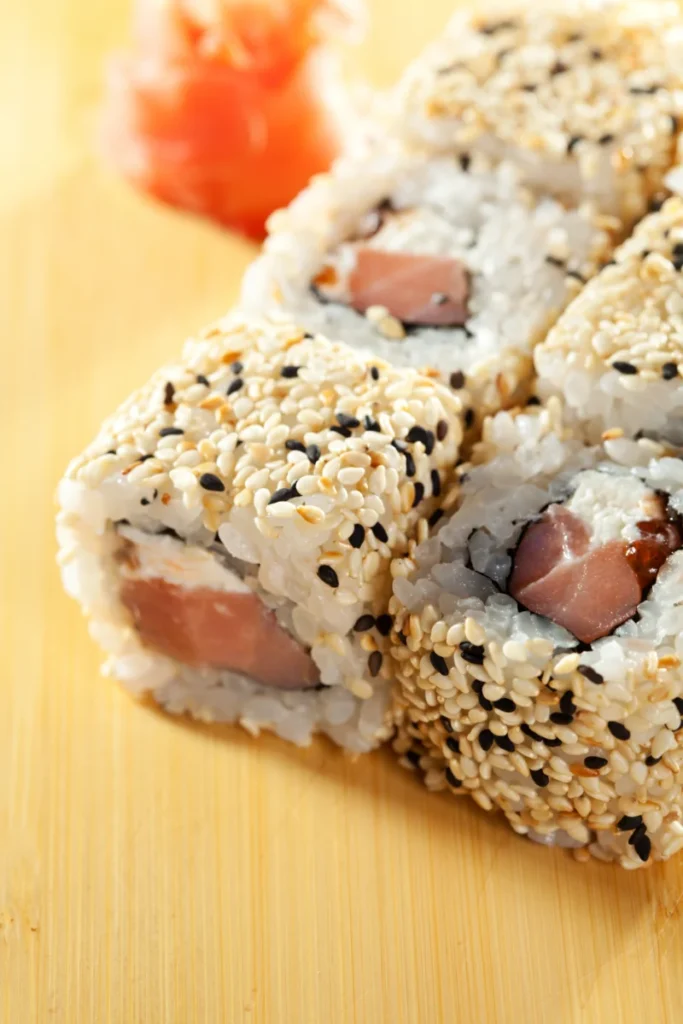Embarking on a culinary journey often takes us through a labyrinth of flavors and traditions that transcend borders, and one such delectable adventure is the exploration of the Alaska Sushi Roll. This dish shines in Japanese cuisine and has won hearts worldwide, far beyond Alaska’s icy landscapes. In this article, we explore the Alaska Sushi Roll deeply. We’ll uncover its origins, how it’s made, and its cultural impact. We’ll cover traditional recipes and modern twists. By the end, you’ll be eager to try making your own Alaska Sushi Rolls.
Introduction to Alaska Sushi Roll
Overview of the Alaska Sushi Roll
The Alaska Sushi Roll, a concoction as intriguing as the region it’s named after, is a culinary masterpiece that combines the delicate flavors of fresh seafood with the crisp texture of vegetables, all wrapped in a blanket of vinegared rice and seaweed. Unlike its more flamboyant cousins in the sushi family, the Alaska Sushi Roll exudes a sense of simplicity and elegance, making it a favored choice for both sushi novices and connoisseurs.
The origin of the Alaska Sushi Roll is a mystery. Some say Alaska chefs created it to showcase local seafood. Others believe it was chefs from the lower 48, as a tribute to the north’s rich seas. Despite its unclear beginnings, the Alaska Sushi Roll has earned its spot in sushi history. It delivers the ocean’s freshness in every bite.
Popularity and Variations
The Alaska Sushi Roll has sailed far in popularity, beyond mountains into city streets worldwide. Sushi lovers gather to feast on this oceanic delight, with countless variations to suit different tastes. Chefs get creative, adding king crab or smoked salmon, paying tribute to Alaska’s wilderness and adding depth to the roll. Each variation showcases the enduring appeal and adaptability of this beloved dish, proving traditional cuisines can evolve.
Stay tuned as we unwrap the secrets to crafting the perfect Alaska Sushi Roll, from selecting the freshest ingredients to mastering the art of sushi rolling. Whether you’re a seasoned sushi maker or a curious newcomer, our journey through the world of Alaska Sushi Rolls promises to enrich your culinary repertoire and tantalize your taste buds.
The Making of Alaska Sushi Roll
Ingredients and Substitutions
The journey to creating an exquisite Alaska Sushi Roll begins with gathering the right ingredients. Traditionally, this roll includes fresh salmon (often smoked or raw), avocado, cucumber, and crabmeat, all snugly wrapped in sushi rice and nori (seaweed). However, the beauty of sushi lies in its adaptability, allowing for various substitutions to cater to different dietary needs or taste preferences.
For those who prefer a vegetarian twist, feel free to swap out the seafood for an assortment of veggies like bell peppers or carrots. And if you’re aiming for a low-carb version, consider using cauliflower rice instead of traditional sushi rice. The possibilities are as vast as the Alaskan wilderness!
Step-by-Step Recipe
1. Prepare the Sushi Rice:
Start by cooking your sushi rice according to package instructions. Once cooked, season it with a mixture of rice vinegar, sugar, and salt. The key to perfect sushi rice lies in its stickiness, making it easy to shape and roll.
2. Slice the Ingredients:
Thinly slice the salmon, avocado, and cucumber into long strips. If you’re using crabmeat, ensure it’s shredded or cut into manageable pieces. This step is where precision meets artistry, as the size of your slices contributes to the roll’s final appearance and texture.
3. Lay Out the Nori:
Place a sheet of nori on a bamboo sushi mat. With wet hands (to prevent sticking), spread an even layer of rice over the nori, leaving a small margin at the top edge rice-free. This technique ensures your roll seals properly.
4. Arrange the Fillings:
On the rice, lay out your slices of salmon, avocado, cucumber, and crabmeat. Remember, the secret to a balanced roll is not to overfill it. The art of sushi is in the harmony of its components.
5. Roll it Up:
Here’s where the magic happens! Using the bamboo mat, begin to roll the sushi tightly from the bottom, applying gentle pressure to keep the fillings in place. When you reach the end, use the rice-free margin of nori to seal the roll.
6. Slice with Confidence:
With a sharp, wet knife, slice the roll into bite-sized pieces. A good tip is to clean your knife between cuts to ensure a clean slice each time.
7. Serve with Pride:
Arrange your Alaska Sushi Rolls on a plate, accompanied by soy sauce, pickled ginger, and wasabi. Each bite promises an explosion of flavors, textures, and the joy of having created something truly special.
Crafting the perfect Alaska Sushi Roll might seem daunting at first, but like any art form, it becomes more intuitive with practice. Don’t be afraid to experiment with different fillings or presentation styles. After all, the essence of cooking lies in creativity and personal expression. As we continue to explore the world of Alaska Sushi Rolls, remember that each roll is a canvas, waiting for you to leave your mark.
Serving and Enjoying Alaska Sushi Roll
Serving Suggestions
Once you’ve mastered the craft of making an Alaska Sushi Roll, presenting it becomes the next thrilling chapter. A beautifully arranged plate of sushi rolls not only captivates the eyes but also elevates the dining experience. Start by arranging your slices in a circular pattern or a straight line on a minimalist plate for that elegant touch. Garnishes play a crucial role; a sprinkle of sesame seeds, a bed of microgreens, or even a drizzle of teriyaki sauce can transform your dish from home-cooked to haute cuisine.
Don’t forget the accompaniments – soy sauce for dipping, wasabi for that fiery punch, and pickled ginger as a palate cleanser between bites. Each element introduces a new layer of flavor, enhancing the overall enjoyment of your Alaska Sushi Roll.
Cultural Significance
The Alaska Sushi Roll, while a simple dish at heart, carries with it a story of cultural exchange and adaptation. Originating from Japan, sushi has traversed oceans and been embraced by various cultures, each adding its unique twist. The Alaska variant, with its use of salmon and avocado, reflects not just Japanese culinary traditions but also the rich seafood culture of Alaska.
This fusion of flavors and techniques showcases the beautiful synergy between different culinary worlds, highlighting how food can be a universal language that brings people together. Savoring an Alaska Sushi Roll is more than just enjoying a meal; it’s an appreciation of the craftsmanship involved and the diverse cultures it represents.
As we delve deeper into the nuances of sushi making and tasting, it becomes evident that the journey of the Alaska Sushi Roll from kitchen to palate is a tapestry of tradition, innovation, and artistry. Whether you’re a seasoned sushi lover or new to the world of Japanese cuisine, the experience of crafting, presenting, and enjoying this delightful dish is bound to leave you enriched and inspired.
So, gather your ingredients, roll up your sleeves, and let the adventure begin. With each roll and slice, you’re not just making sushi; you’re weaving a story of culinary exploration and shared experiences. Here’s to the joy of sushi making, and may your Alaska Sushi Roll be a testament to the beauty of food as a bridge between cultures.
Nutritional Information
The Alaska Sushi Roll isn’t just a feast for the senses; it’s also a bundle of nutritional benefits that cater to a healthy lifestyle. Understanding the nutritional content of this delicious sushi variant can help you appreciate not just its flavors but also its contribution to your well-being.
Health Benefits and Considerations
Rich in Omega-3 Fatty Acids:
Thanks to the inclusion of salmon, the Alaska Sushi Roll is a fantastic source of omega-3 fatty acids, known for their heart-health benefits. Omega-3s can reduce inflammation, lower blood pressure, and decrease the risk of heart disease.
High in Protein:
Both the salmon and crabmeat in an Alaska Sushi Roll contribute to its high protein content. Protein is essential for muscle repair, growth, and overall body function, making this sushi roll an excellent choice for those who lead an active lifestyle.
Loaded with Vitamins and Minerals:
Avocado, a key ingredient in the roll, isn’t just there for its creamy texture; it’s also packed with vitamins C, E, K, and B-6, along with riboflavin, niacin, folate, pantothenic acid, magnesium, and potassium. These nutrients are vital for energy production, brain health, and immune system function.
Low in Saturated Fat:
The Alaska Sushi Roll is relatively low in saturated fat, making it a heart-healthy option. Choosing this sushi roll can be a smart move for those watching their cholesterol levels.
Dietary Considerations:
For those with dietary restrictions, the Alaska Sushi Roll is adaptable. With gluten-free soy sauce, it becomes gluten-friendly. Vegetarians can substitute the seafood with tofu or additional vegetables, making it a versatile choice for various dietary needs.
While the Alaska Sushi Roll boasts numerous health benefits, it’s also wise to consume it in moderation, especially if you’re watching your sodium intake due to the soy sauce. Additionally, ensuring the seafood is fresh and properly handled is crucial to avoid any foodborne illnesses.
Incorporating the Alaska Sushi Roll into your diet offers a delightful way to enjoy a range of nutrients while indulging in the rich flavors of Japanese cuisine. As we continue to explore the multifaceted world of sushi, it’s clear that this dish is more than just a culinary delight; it’s a testament to the balanced fusion of taste and health. Whether you’re enjoying a roll as part of a balanced diet or as an occasional treat, the Alaska Sushi Roll is a choice that satisfies both the palate and the body.
FAQs
What is a Alaska roll made of?
An Alaska roll is typically made of raw salmon, avocado, and cucumber, all wrapped up in sushi rice and seaweed (nori). Some variations might include crab meat or cream cheese, but the core ingredients celebrate the fresh, rich flavors of salmon.
What is the difference between a California roll and an Alaska roll?
The main difference between a California roll and an Alaska roll lies in their primary ingredients. A California roll usually contains imitation crab (or real crab), cucumber, and avocado. It’s also known for its inside-out rice presentation, with the rice on the outside and nori inside. On the other hand, the Alaska roll focuses on raw salmon as its main component, offering a different flavor profile that highlights the taste of fresh fish.
How many calories are in an Alaskan roll?
The calorie content of an Alaskan roll can vary depending on the exact ingredients used and their proportions. However, on average, a standard 6-8 piece Alaska roll may contain approximately 250 to 300 calories. This estimate can change with the addition of ingredients like cream cheese or variations in the size of the roll.
Can I make an Alaska Sushi Roll without a bamboo mat?
Yes, you can! While a bamboo mat helps in rolling sushi neatly, you can use a piece of parchment paper or a clean kitchen towel as an alternative. The key is to maintain even pressure as you roll to ensure the ingredients stay compact.
Is the Alaska Sushi Roll suitable for a vegetarian diet?
Absolutely! By substituting seafood with ingredients like tofu, bell peppers, or other vegetables, you can easily transform the Alaska Sushi Roll into a vegetarian delight. The versatile nature of sushi means it can be adapted to meet various dietary preferences.
How do I store leftover Alaska Sushi Rolls?
Leftover Alaska Sushi Rolls can be stored in an airtight container in the refrigerator for up to 24 hours. It’s important to note that the quality, especially of the rice, may decline, so it’s best enjoyed fresh.
What are some common mistakes to avoid when making Alaska Sushi Rolls?
A common pitfall is overfilling the roll, which can make it difficult to seal and slice. Additionally, ensure your hands are wet when handling sushi rice to prevent sticking, and always use a sharp knife to cut the rolls for clean slices.
Can I use brown rice instead of sushi rice for a healthier option?
Yes, brown rice can be a healthier alternative to white sushi rice, offering more fiber and nutrients. However, it’s worth noting that brown rice has a different texture and flavor, which may slightly alter the traditional taste of the Alaska Sushi Roll.
What’s the best way to slice salmon for an Alaska Sushi Roll?
For the best texture and ease of rolling, slice the salmon against the grain into thin strips. This ensures the salmon is tender and integrates well with the other ingredients in the roll.
The journey through the art of making and enjoying the Alaska Sushi Roll is both a culinary adventure and a testament to the versatility of sushi. With each question answered, we unravel a bit more of the mystery and mastery behind this beloved dish, inviting both seasoned chefs and beginners alike to explore the endless possibilities that sushi offers. Whether you’re experimenting with substitutions, tackling the roll without a bamboo mat, or adapting the recipe to fit dietary needs, the Alaska Sushi Roll serves as a delicious canvas for creativity and enjoyment.
Advanced Tips for Perfecting Your Alaska Sushi Roll
Embarking on the sushi-making journey requires patience, practice, and a sprinkle of creativity. For those who’ve already mastered the basics of the Alaska Sushi Roll, these advanced tips will elevate your sushi artistry to new heights.
- Temperature Matters: The temperature of your hands can affect the texture of the rice. Cooler hands prevent the rice from becoming overly sticky, maintaining the perfect consistency for your sushi roll.
- Balance is Key: Achieving the right balance of rice, seafood, and vegetables is crucial. Too much filling can make the roll difficult to close, while too little may leave it lacking in flavor and texture. Aim for harmony in every bite.
- Sharpness Counts: A sharp knife is essential not just for slicing the roll but also for preparing the ingredients. Clean, precise cuts of fish and vegetables contribute to the overall aesthetic and eating experience of the sushi.
- Experiment with Flavors: Don’t be afraid to introduce non-traditional ingredients into your Alaska Sushi Roll. Elements like cream cheese, spicy sauces, or even fruits can add an exciting twist to the classic recipe.
Conclusion: Embracing the Sushi Journey
The journey of discovering, creating, and enjoying the Alaska Sushi Roll is more than just about mastering a recipe; it’s about embracing a culinary culture that values precision, balance, and artistry. As we reflect on the insights shared throughout this series, here are key takeaways to carry forward on your sushi-making adventures:
Patience Pays Off: Sushi-making is an art that requires patience and attention to detail. From preparing the rice to slicing the ingredients and rolling the sushi, demands mindfulness and craftsmanship.
- Experiment with Confidence: Equipped with the fundamentals of the Alaska Sushi Roll, dare to experiment with flavors, textures, and ingredients. Your next sushi creation could be the next big hit on your dinner table or even in your local sushi scene.
- Sustainability Matters: As lovers of sushi, it’s crucial to be mindful of the sources of our seafood. Opting for sustainable and ethically sourced fish not only contributes to the health of our oceans but also ensures the future of the sushi tradition.
- Share the Joy: Sushi is more than food; it’s an experience to be shared. Invite friends and family to roll sushi with you, share your creations on social media, or host a sushi night. The joy of sushi is amplified when shared with others.
Final Words
As you continue to explore the vast and vibrant world of sushi, remember that each Alaska Sushi Roll you make is a reflection of your journey in the art of sushi. From the shores of Alaska to the sushi bars around the globe, this dish embodies the spirit of innovation, tradition, and communal dining that sushi is all about.
We hope this series has ignited a passion for sushi-making within you and that the Alaska Sushi Roll serves as a stepping stone into the broader, flavorful world of Japanese cuisine. May your rolls be tight, your fish be fresh, and your sushi adventures be boundless. Here’s to the endless possibilities that await in the realm of sushi, where tradition meets creativity, and every bite tells a story.
Thank you for joining us on this culinary journey. Now, armed with a bamboo mat, fresh ingredients, and a dash of inspiration, step into the world with confidence and let the magic of sushi-making unfold.
More Delicious Recipes:
- Sake Sushi: Dive into the world of Japanese cuisine with our tantalizing Sake Sushi recipe, marrying the delicate flavors of fresh fish and aromatic rice with the subtle kick of sake.
- Fried Polenta: Craving comfort food with a twist? Our Fried Polenta recipe promises a crispy, golden exterior encasing a creamy, comforting center, perfect for satisfying any appetite.




1 thought on “Alaska Sushi Roll: Crafting and Variations”